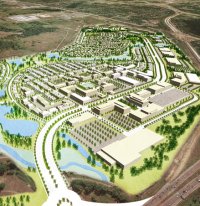The Twin Cities Army Ammunition Plant (TCAAP) site in Arden Hills, Minnesota is being prepared for a new, more peaceful and less polluting role – solar electricity generation.
TCAAP produced .30, .50 and .45 caliber ammunition for the US Army. The facility was listed as a “Superfund” site – polluted locations requiring a long-term response to clean up hazardous material contaminations – in 1983.
According to the EPA, wastes were disposed at 14 areas within TCAAP between 1941 and 1981. This waste included volatile organic compounds (VOCs), semi-VOCs, metals, polychlorinated biphenyls (PCBs), cyanide, pesticides, and explosives. VOC contamination spread to surrounding communities and contaminated regional groundwater resources, used for municipal and private water supplies.
Cleanup began in 1991 and by mid- 2002, the TCAAP remedial and removal actions were largely complete, but work has been ongoing since. An extensive monitoring program for groundwater and surface water is currently active and will continue well into the future.
Ramsey County purchased a parcel of the TCAAP site from the U.S. government in April 2013 and is re developing it as Rice Creek Commons.
According to MPR News, Ramsey County wants to construct build a 40-acre array of solar power panels with a capacity of 8 megawatts on the 427 acre site. The facility would generate enough electricity to meet the needs of a development that would house 4,000 people and employ about the same.
“It is kind of a transformative moment,” said Heather Worthington, the county’s deputy manager. “It will be pretty amazing. You’re taking something that’s a negative and really making it a positive.”
Ramsey County will put out a request for proposals for construction of the facility later this year.
The generation of solar power can be a perfect use for Superfund and “brownfield” sites – abandoned or underused industrial and commercial land where the ground may be too toxic for other types of developments.
Increasingly, garbage dumps that have been decommissioned are also being used for solar farms, such as the Freshkills project in New York City; once the site of the largest landfill in the world. This will be NYC’s largest solar installation at 10 MW capacity and will generate enough power for thousands of homes.
Image credit: Rice Creek Commons.













































